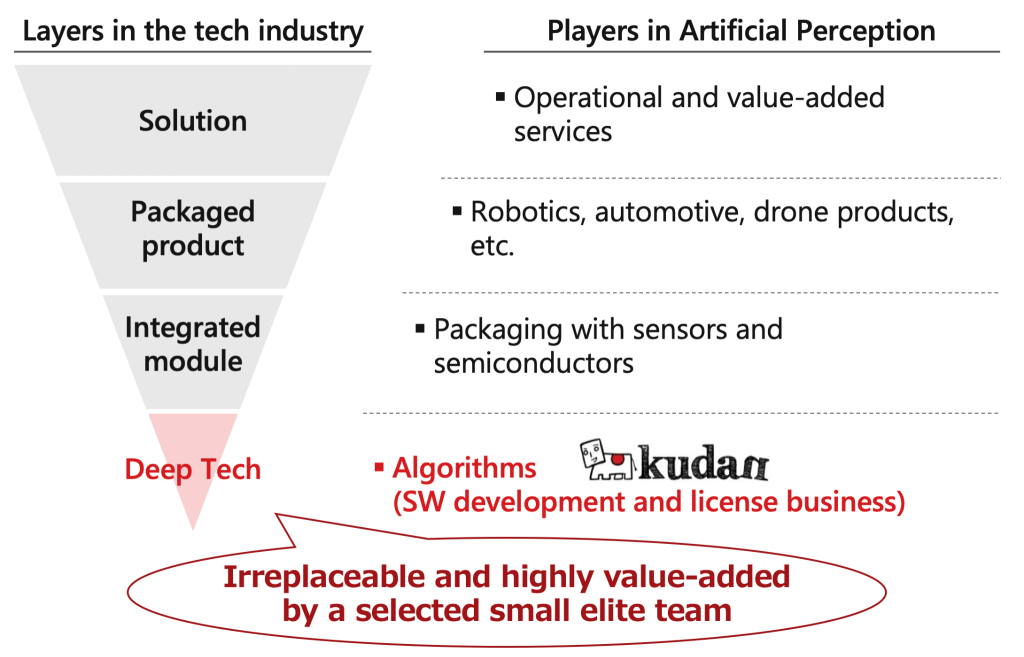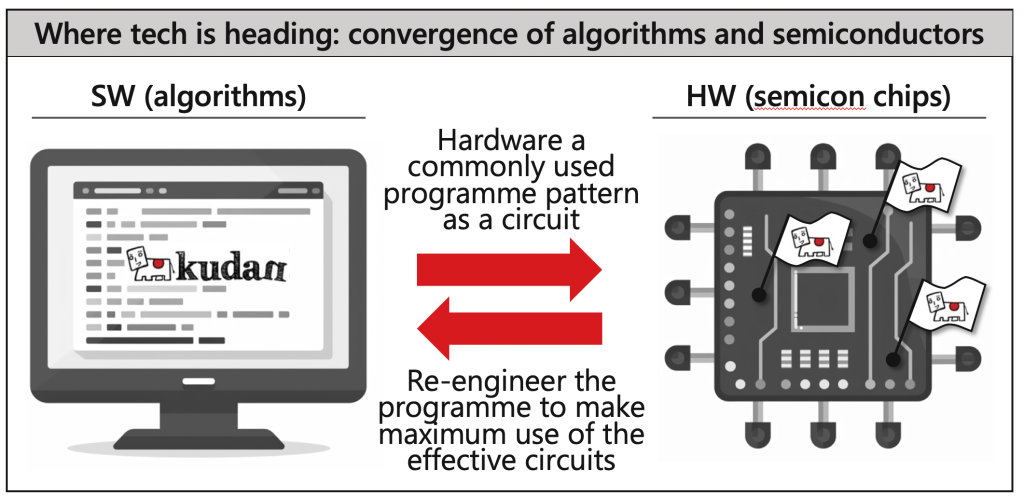3
“Ultra-deep tech” to underpin industry from the deepest layer
The deepest layer in the industry aimed by a select elite small team
Recently, many companies have referred to themselves as “deep tech,” but only a very limited number of companies really compete based on advanced technology itself.
While multiple technology layers structure the technology industry, Kudan is located in the deepest core technology layer that cannot be broken down any further. Here, Kudan concentrates on the most fundamental information processing logic and methods of Artificial Perception (AP), which are so-called algorithms. The majority of other companies involved in Artificial Perception (AP), on the other hand, mostly integrate deep technologies with different technologies for integrated modules, or assemble packaged products, or deliver solutions to the end-users.

The deepest layer, where Kudan is located, is possible to deliver overwhelming value by a selected small elite team versatility across multiple regions and application segments, unlike the upper layers, which can easily differentiate and be segmented by regional or applicational categories. In addition, in the same theory as ‘the bottom block is the hardest to replace in building blocks’, the deepest technology has the advantage of being difficult to replace once it is in place.
As such, this deepest technology is a very promising and exciting business area, but as a suitable challenge, the technology must compete for the top global position, and the business must also expand globally. Companies taking on such challenges are scarce in Japan now, and no Japanese companies are focusing on this depth in the Artificial Intelligence (AI) and semiconductor industries. Many start-ups advertise innovation through inherent advanced technology, but the main battleground of their business is usually in the upper tier, with the majority of resources devoted to system integration and individual customization for product packaging rather than refining sharp, deep technology.
Kudan is a world-class tech firm that focuses on this area of the most profound technology, which can be considered true deep tech, to create overwhelming value with a selected small elite team (see link).
The “ARM-like position” as the power behind the scenes in the industry
There are only a limited number of deep technology companies worldwide, the largest number in the US and some in Europe. In this context, Kudan advocates and aims to be a company like ARM, also born in the UK.
ARM, made famous by its massive acquisition by Softbank, provides deep technology that goes one step deeper than the CPU architecture itself, which is somehow both hardware and software.
Compared to semiconductor industry giants NVIDIA and Intel, ARM is by far the smallest organisation and has very little consumer awareness, but because it is at the deepest level, it is versatile and ubiquitous, with an impressive market share of over 95%.
As the ‘eye of the machine’, Kudan aims for an ARM-like position as the power behind the scenes in the industry, with a selected small elite team, maximum-value, hard-to-replace.
Ultra-deep tech – Algorithms merge with semiconductors
By diving into this ultra-deep tech, Kudan’s technology will merge with semiconductors in the future. This is the royal road of the technology industry, also taken by other technologies such as Artificial Intelligence (AI), where algorithms software merge with semiconductor circuits as the technology becomes more prevalent.

For example, software is an instruction for information processing, but it can be directly mounted on semiconductors as hardware in the form of electrical circuits. The more this fusion progresses, the more both software and hardware maximise their performance and efficiency.
Compared to Artificial Intelligence (AI), Artificial Perception (AP) is still on the eve of widespread adoption, but what we are looking at is exactly the path that Artificial Intelligence (AI) has followed, and for this reason we believe that Kudan’s efforts will be of great significance to the semiconductor industry. (Reference link)
